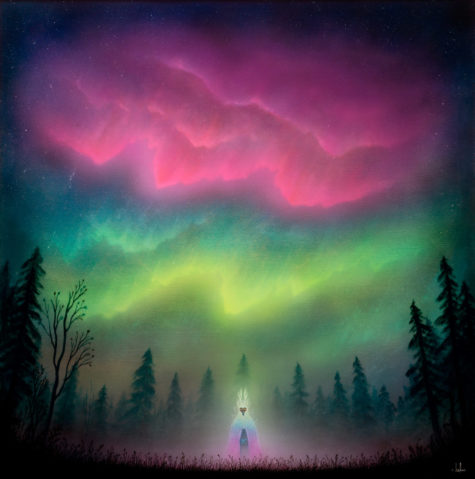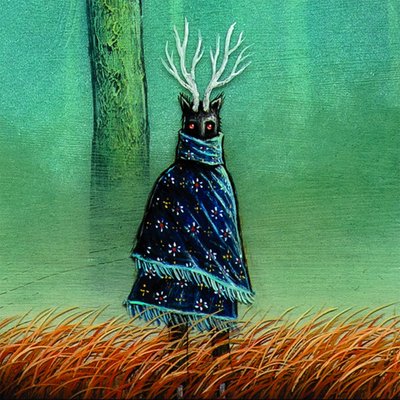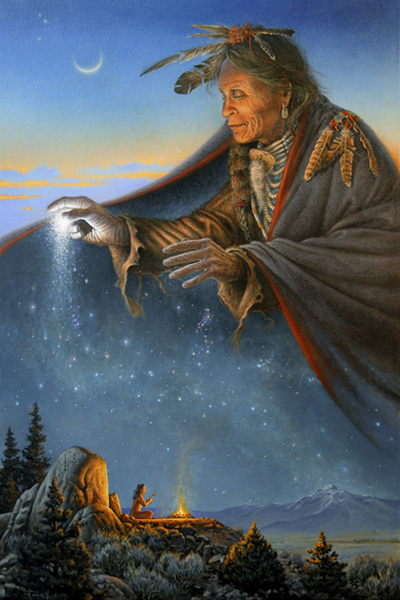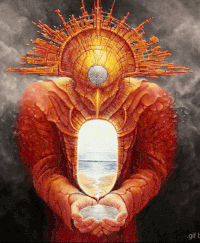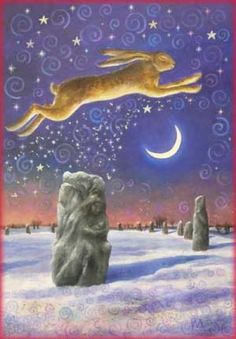Native Spirituality
In their traditional system, Ojibwa children are guarded by a spiritual vision they acquire after their births. Their first names are taken from a vision or dream their mothers have during pregnancy, some event of spiritual significance that happens during their early lives or through a medicine person’s intercession with the spirits who seeks a vision and a name on their behalf.
But at adolescence, children are free to search on their own for a vision and a name to serve them through their adult lives. All boys are urged to quest for their names and girls are free to do so as well, though it is not required.
Children are separated from their people for a period of time and left alone upon the land, very often fasting, sometimes journeying, sometimes lying still, but all praying and waiting for a touch from spirit. They seek to learn what dogma cannot tell them, what not even the wisest one among their people can give them: an understanding of their innermost self and an awareness of the greater purpose for which they were born.
Girls may, if they choose, accept the vision of the Earth mother as Guardian Spirit and take their power from her through their capacity to bring forth life. The occasion of their first menstruation would then be an important rite of passage.
Both boys and girls who choose to seek their own visions are isolated from their people, consciously entering the world of the spirits with a willingness to release what they have believed about themselves in the past, while they fast and pray. At the end of three or four days, the elders or medicine people help to translate the visions.
Those who have returned from their fasts very often are named for the Guardian Spirit which revealed itself through their vision, some energy or spirit of nature that is believed to be each person’s personal access to strength and wisdom. The Ojibwa believe that every animal and plant has both a physical and a spiritual purpose in the Earthly ecology. The guardian is often closely associated with purpose, so those whose guardians are involved with healing might become aware of their own healing gifts through the contact.
The name and the vision are shared or kept secret, depending on the nature of the individual vision. But the acquisition of a name from the spirits is a cause for public celebration. Traditionally, this ritual made sure that all adolescents entered adulthood with some vision or purpose to which they were responsible. This was practical psychology, helping to ease the transition period for the young from the dependency of childhood to the responsibility of adult life.
Out of the context of its significance as a specific cultural drama, the ritual of the Vision Quest is a potent reflection of the rite of passage into spiritual maturity that can come at any physiological age.
When we were children, along with the protection and sustenance that we required, we allowed the world to create our contexts and our environments. We were given identities by our parents, our religions and our schools and we tried to match what we had been given. We were rarely encouraged to question or outgrow the visions that had been bequeathed to us, often being rewarded for accepting and staying within the structures, censored for our opposition.
But for many of us these visions just don’t work and we fall into confusion or despair. The moment we begin to grow is the one in which we question the identities we have been given and wonder who we are apart from our relationships with others and the work we do, and what our purpose is for being on the Earth at all.
The first impulse in seeking vision is thus an admission of ignorance. Whenever we release a definition of ourselves which served us for one period of our lives in search of a deeper, more powerful understanding, whenever we question the majority view or leave a group with which we have been an active part, we are beginning a Vision Quest.
With the release of the past and the willingness to leave the people behind and to go on alone, we lose both security and certainty. Fear, depression and confusion are all emotions evoked by the beginning of the quest, symbolized by going alone into the woods and into the night.
~From: A Voice From The Earth
In many ways the Earth is like True-Hearted Woman and humanity the husband who neglects her. Still she provides for us, she feeds us, clothes us and keeps us warm, though we neither recognize nor appreciate her gifts. Our eyes are turned to the objects of our desire which we will attain no matter what the cost. In most cases this price is also paid by the Earth.
But even abandoned, even hurt in some ways beyond renewal, the Earth leaves us a child, the possibility of change and hope for the future – if we can choose to live in a different way.
When we begin to view the Earth and its animals, plants and ecosystems as sacred, we will protect and defend the land because our spirituality depends on it. By our own choice and our willingness to listen to the land, we can become native again, even in our cities whose concrete can cover but not destroy the Earth that lies beneath.
But when we cease to uphold the separation between ourselves and the land, refinding our reverence and respect for it, allowing it to become as intrinsic to our spirituality as our compassion for other human beings, we may find ourselves short of the tools necessary for what that means.
For many non-Western cultures a Vision Quest is one method of direct communication with the Earth. Specific details of the experience vary widely but the basic purpose seems to be universal.
The Vision Quest is a ritual which we have all experienced without even being aware of it, right within the context of our own lives, even in our cities. A passing conversation with a stranger, a sentence in a book, an idle musing on a bus, any of these can provide moments of vision if we have the openness to allow ourselves to understand what is really happening around us.
For Example:
The city-dwelling unconscious Vision Quester who is unhappy with his job, the state of the world and his relationships, but who can’t put his finger on why he isn’t happy or “what it’s all for,” takes off from work for an afternoon and goes for a walk in a park, alone.
He is startled when he comes upon a huge spider’s web which crosses his path. It has been raining intermittently but suddenly a ray of sunlight pierces through the trees. The tiny drops of water, which hang like diamonds from the web, turn into flames. Now within the complexity and confusion he can see order, a delicate beauty, a shadowy sense of purpose.
He goes home, more sure of his ability to move through his conflict, to make decisions of positive change and to allow greater intimacy in his relationships. Without even being aware of it, he has successfully completed an ancient ritual and received the healing inherent within it.
We have access to everything the world has known, if we can learn to listen to the stones and the stories they have to tell, if we hear the winds speak who have been everywhere and heard everything since the beginning of time. The world will always provide vision, if we allow ourselves to be alone, then open our eyes and look as if for the first time, at what has been around us all along.
From: A Voice From The Earth
In the very earliest of times,
When both people and animals lived on the earth,
A person could become an animal if he wanted to
And an animal could become a human being.
Sometimes they were people
And sometimes animals
And there was no difference.
All spoke the same language.
That was a time when words were like magic.
The human mind had mysterious powers.
A word spoken by chance
Might have strange consequences.
It would suddenly become alive
And what people said wanted to happen
Could happen ~
All you had to do was say it
Nobody could explain this:
That’s the way it was.
~An Old Eskimo story
A vision quest is a rite of passage, similar to an initiation, in some Native American cultures. In traditional Lakota culture the Hanblecheyapi (vision quest, literally “crying for a vision”) is one of seven main rites.
Vision quest preparations involve a time of fasting, the guidance of a tribal Medicine Man and sometimes ingestion of natural entheogens; this quest is undertaken for the first time in the early teenage years.
The quest itself is usually a journey alone into the wilderness seeking personal growth and spiritual guidance from the spirit, sometimes Wakan Tanka.
Traditionally, the seeker finds a place that they feel is special, and sits in a 10 foot circle and brings nothing in from society with the exception of water.
A normal Vision Quest usually lasts two to four days within this circle, in which time the seeker is forced to look into his soul.
It is said that a strong urge to leave the Quest area will come to the seeker and a feeling of insanity may set in. However, the seeker normally overcomes this by reminding him or herself of the overall outcome of the quest, causing the mind to stop wandering on random thoughts. The individual can generally find solace in the fact that he or she will not die in just two to four days.
Some have claimed grand visions on their first Vision Quest while others have not. It is an individual experience and often subject to the emotional, spiritual, and physical make-up of the person.
Native American totems are said to be capable of speaking through all things, including messages or instructions in the form of an animal or bird.
Generally a physical representation of the vision or message such as a feather, fur or a rock is collected and placed in the seeker’s medicine bag to ensure the power of the vision will stay with the individual to remind, protect or guide him.
Since the beginning of this cycle of time, humanity has returned to nature to connect with spirit and to seek answers to problems of the physical realms, especially in this timeline when the messages of prophecy reveal themselves to the seeker.
There is something about being alone in the wilderness that brings us closer and more aware of the 4 elements and our connection to a creational source. We go to seek truths and divine realization, just as many of the ancient prophets did in their time.
In its own way – the vision quest is an Initiation not unlike the days of the ancient mystery school teachings where one learns about themselves and the mysteries of the universe are often revealed to them. It is a time of internal transformation and renewal.
- Who am I?
- Why am I here?
In a vision quest, conditions are set up that allow the soul to move beyond the illusions of the little self and enter the unity of the inner whole. It is a time of fasting – praying – and being in nature.
It is a period of solitude in which we seek an inner revelation – a vision -which grants profound meaning and direction to our life.
This initiation leads to maturity and an understanding of our responsibility to ourselves, our society, our natural environment, and our soul.
Though the Vision Quest is associated with Native Americans traditions – it is practiced all over the world.
As an expression of the archetypal “Heroic Journey,” the vision quest has been enacted in religious pilgrimages, mythological tales (including the story of the search for the Holy Grail), and our own daily pursuit of truth and purpose.
Today, there are companies which sponsor vision quests. They provide a wilderness area in which it is to occur, and they give instructions and guidance before and after the event.
In Native American traditions these times of inner trial are marked liked passages. Time is set aside to honor them. It might take a day, a week, a month – whatever is necessary to complete the transformation and get the answer one seeks.
